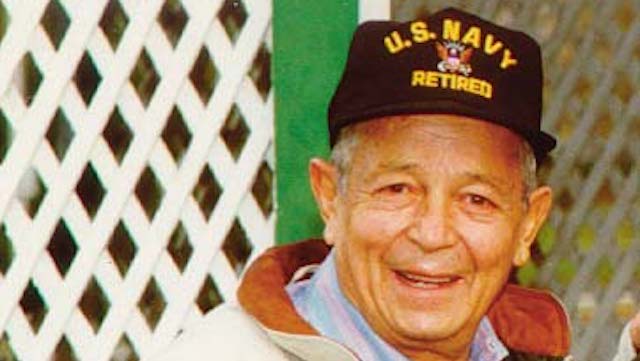
Twenty-something New Mexico native Manuel Ray Perez had already been honorably discharged by the U.S. Army, but after the Japanese attack on Pearl Harbor that started World War II, he knew he had to get back in the fight.
That determination, and a toss of the coin, put him on Omaha Beach, Normandy, Nazi-occupied France, on D-Day, 78 years ago today.
OFFICIAL DEFENSE DEPARTMENT BIOGRAPHY:
He was a yeoman on “Easy Red” sector of Omaha Beach with the 6th Beach Battalion — bullets screaming past him and hitting buddies and strangers all around during the Invasion of Normandy. And he was there because all he won a coin toss.
Retired Yeoman Chief Petty Officer Ray Perez has asked himself why he was there many times since then. He started asking in the hours after he and the 367 other enlisted men and 42 officers in his battalion cleared the way for the coming allied forces behind them. He wasn’t just there on D-Day, Perez was in one of the first units to hit the beach.
Beach battalions were a new kind of unit in World War II, often described as traffic cops for the invasion. Perez’s battalion was attached to the American Army 5th Engineer Special Brigade. Its mission was tough: “To tear up the enemy’s beach defenses when the time came, open safe approaches for landing craft, and build ‘hurry up’ roads to get tanks, artillery, trucks and infantry off the beaches and into the back country where they could engage the enemy on something like even terms,” he said. Perez’s personal job was to support his skipper, Cmdr. Eugene Carusi.
But many things went wrong that day. Perez’s battalion, for example, was supposed to hit the eastern side of Omaha Beach — the “Dog Red” sector — which had the most intense fighting. But they didn’t due to a strong eastward tide, along with enemy fire, which caused units to land in the wrong location or out of sequence. He credits that landing mistake with helping to spare his life. But the landing still cost about 22 percent of his unit in casualties, along with 52 percent of the men attached to the Navy’s demolition teams tasked with clearing the steel water obstacles — called hedgehogs — for the landing forces.
Even so, Perez was proud to be there. In the planning stages of the invasion, Perez said the men in his battalion knew something huge was being planned and knew they would be part of history. “Our whole training obviously was predicated on the determination to make one final tremendous, all-out effort not only to stop the Nazi horde, but to roll it back.” Yet Perez wasn’t certain he’d be with the unit for the assault. He and another yeoman had been told to decide which one of them would hit the beach. They tossed a coin, and “the coin fell ‘heads,’ so I won,” Perez said.
While so many heroes were born that day on Omaha Beach, few were ever recognized in any formal ceremony for bravery. But if Perez is any indication, they didn’t feel slighted. They knew what they were doing was important. Perez said he was there that day simply, “Because that’s the way it was.” He seems happy having lived through the greatest Naval invasion in history, then going on to complete a full career.
Perez was a high school graduate with a 16-month stint in the Army when he was honorably discharged as a sergeant in November 1940. He sustained an injury while playing football and was considered disabled. After some recuperation time, Perez decided to try the Navy. “I was going to go back into the Army, but the lines were too long” at the recruiting station, he said. The Navy kept turning him down, but the Japanese attack on Pearl Harbor changed that.
Declared fit for duty, Perez enlisted in the Navy on April 13, 1942. He was 22, and was bound for radio school. Perez had always liked machinery, and he had no problems with the theory of Morse code. But he soon realized he couldn’t distinguish tones as separate beyond 14 words per minute, the point at which “everything became a buzz” to his ears. The graduation requirement was 22 words per minute. But he could type, so he worked in the personnel office at the school in Oxford, Ohio, until reassigned to the beach battalion. Perez headed for Camp Bradford, in Little Creek, Va., to the Amphibious Training Base.
In October of 1943 he arrived at 6th Beach Battalion and made yeoman third class — Y3 — the following month, then promoted again three months later. So it came to be that Ray Perez, Y2, 24 years old, 5-foot-6 and all 138 pounds hit the beach with his battalion on June 6, 1944.
He remembers that day mostly in slow motion. Time doesn’t pass in a normal fashion when trying to survive an offensive for which the other side had prepared. Perez watched as the landing craft on both sides of him were picked off with enemy shells. “The landing craft seemed to rise bodily out of the water, burst apart in a great mushroom of red-orange flame, and the next moment there were hardly even fragments visible to mark the spot,” he said. The landing crafts had been carrying explosives.
Perez was in a personnel carrier with about 200-250 men all ready to heave over the side with the next shell. But they grounded slightly ahead of that shell. The ramp dropped and Perez followed his skipper, Carusi, over the ramp into neck-high water a second before enemy artillery scored a direct hit on the ramp. “Then I got scared, and shook,” he said. “I didn’t think I’d make it.” Carusi told him to find a radio. Heavily laden with a mixture of Army and Navy gear, Perez fought his way through hedgehogs while dodging enemy machine gun and automatic weapons fire, the water churning around him.
Perez said the less than 100 yards to the shoreline looked like a mile, a trip that took him at least two hours to make. After zigzagging his way to the beach he was exhausted and lost.
But there was no place to find cover Perez discovered, after seeing as a severely wounded Army tanker. “The guy was sitting on the beach at the water’s edge, leaning up against a tank with its treads knocked off. His eyes were glassy, just the faintest suggestion of movement in the pupils. Both his legs were broken and he held his guts in his two hands stretched out in front of him,” he said. Visibility was nearly non-existent, and this was the first thing Perez saw as he made it out of the water. He didn’t think, he just reacted. After jabbing the soldier in the leg with morphine, Perez and another soldier pulled the injured man around to the back of the tank so he was out of the line of fire. He screamed with everything he had for a corpsman, although he could barely hear himself. He got lucky — he got his battalion’s corpsman’s attention.
Not forgetting the order to find a radio for his skipper, Perez left the man and headed down the beach. He doesn’t know who the man was or even what happened. “The guy was a soldier and was badly wounded,” Perez said. That was the rule rather than the exception, 120 minutes into D-Day.
Perez survived that day, and action in Europe after that. He did two tours afloat, on USS Charles Badger (DD 657) and USS Ramsay (AG-98). He also served two tours working in the Joint Chiefs of Staff office. He made the jump to Y1 in July 1944 and CYA — chief yeoman — in June 1948. He transferred to the Fleet Reserve in January 1960.
Perez is currently a resident at the U.S. Soldiers and Airmen’s Home in Washington, D.C., nearly 40 years after retiring from the Navy. Although he didn’t plan to live there, he’ll readily admit his pleasure at being there. Perez is among 1,600 residents in the two homes that comprise the Armed Forces Retirement Home, and he is among the 80 percent of the Homes’ residents who served during World War II. Most people at the home have stories to tell: funny, harrowing, sad, enlightening, patriotic. But Perez is probably among the few who can tell the story of the yeoman who helped storm Omaha Beach the day the Allied Forces started driving the Nazi threat into submission, all because he got lucky and won the coin toss.
CPO Perez died in 2003 and is buried in Arlington National Cemetery.
